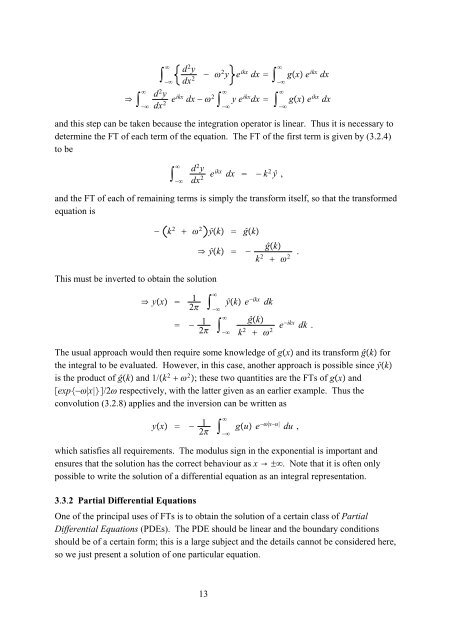Fourier Transforms
Fourier Transforms
Fourier Transforms
You also want an ePaper? Increase the reach of your titles
YUMPU automatically turns print PDFs into web optimized ePapers that Google loves.
−−d 2 ydx 2d 2 y− 2 y e ikx dx gx e ikx dxdx 2 −eikx dx − 2 ye ikx dx − gx e ikx dx−and this step can be taken because the integration operator is linear. Thus it is necessary todetermine the FT of each term of the equation. The FT of the first term is given by (3.2.4)to be−d 2 ydx 2 e ikx dx − k 2 ŷ ,and the FT of each of remaining terms is simply the transform itself, so that the transformedequation is− k 2 2 ŷk ĝkThis must be inverted to obtain the solution yx 12 −21 ŷk − −−ŷk e −ikx dkĝkk 2 2 .ĝkk 2 2 e −ikx dk .The usual approach would then require some knowledge of gx and its transform ĝk forthe integral to be evaluated. However, in this case, another approach is possible since ŷkis the product of ĝk and 1/k 2 2 ; these two quantities are the FTs of gx andexp−|x|/2 respectively, with the latter given as an earlier example. Thus theconvolution (3.2.8) applies and the inversion can be written asyx − 12 −gu e −|x−u| du ,which satisfies all requirements. The modulus sign in the exponential is important andensures that the solution has the correct behaviour as x →. Note that it is often onlypossible to write the solution of a differential equation as an integral representation.3.3.2 Partial Differential EquationsOne of the principal uses of FTs is to obtain the solution of a certain class of PartialDifferential Equations (PDEs). The PDE should be linear and the boundary conditionsshould be of a certain form; this is a large subject and the details cannot be considered here,so we just present a solution of one particular equation.13
















